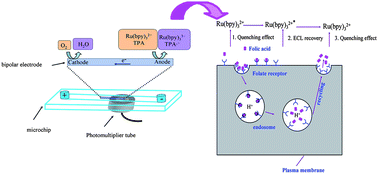Electrochemiluminescence analysis of folate receptors on cell membrane with on-chip bipolar electrode†
Abstract
In this paper we report a transparent bipolar

* Corresponding authors
a
Key Laboratory of Analytical Chemistry for Life Science (Ministry of Education of China), School of Chemistry and Chemical Engineering, Nanjing University, Nanjing, P. R. China
E-mail:
xujj@nju.edu.cn
Fax: (+86)-25-83597924
Tel: (+86)-25-83597924
In this paper we report a transparent bipolar

 Please wait while we load your content...
Something went wrong. Try again?
Please wait while we load your content...
Something went wrong. Try again?
M. Wu, B. Xu, H. Shi, J. Xu and H. Chen, Lab Chip, 2011, 11, 2720 DOI: 10.1039/C1LC20143C
To request permission to reproduce material from this article, please go to the Copyright Clearance Center request page.
If you are an author contributing to an RSC publication, you do not need to request permission provided correct acknowledgement is given.
If you are the author of this article, you do not need to request permission to reproduce figures and diagrams provided correct acknowledgement is given. If you want to reproduce the whole article in a third-party publication (excluding your thesis/dissertation for which permission is not required) please go to the Copyright Clearance Center request page.
Read more about how to correctly acknowledge RSC content.
 Fetching data from CrossRef.
Fetching data from CrossRef.
This may take some time to load.
Loading related content
